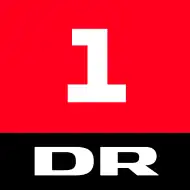 | |
| Country | Denmark |
|---|---|
| Broadcast area | Danish Realm |
| Headquarters | DR Byen Copenhagen, Denmark |
| Programming | |
| Language(s) | Danish |
| Picture format | 16:9 720p (HDTV) |
| Ownership | |
| Owner | DR |
| Sister channels | DR2 DR Ramasjang |
| History | |
| Launched | 2 October 1951[1] |
| Former names | Statsradiofonien TV (1951–1959), Danmarks Radio TV (1959–1964), DR TV (1964–1996) |
| Availability | |
| Terrestrial | |
| DTT | Channel 1 |
| Streaming media | |
| DR TV | www |
DR1 (DR Et) is the flagship television channel of the Danish Broadcasting Corporation (DR). It became Denmark's first television station when it began broadcasting in 1951 – at first only for an hour a day three times a week.
Besides its productions, the channel also broadcasts co-productions with other Nordic countries through Nordvision, as well as a significant amount of programmes from English-speaking countries like the United States, United Kingdom, and Australia, all in the original language with Danish subtitles. Its news programme is called TV Avisen.
Broadcasting hours
- 1951–1966: 10 hours a week (5 programs)
- 1966–1982: 14 hours a day (35 programs a week)
- 1982–1994: 18 hours a day (50 programs a week)
- 1994–2001: 21 hours a day (60 programs a week)
- 2001-today: 24 hours a day
Technological advances
Colour TV
Colour television test broadcasts were started in March 1967, with the first large-scale colour broadcasting occurring for the 1968 Winter Olympics in Grenoble, France.[2] DR officially ended "test" transmissions of colour television on April 1, 1970, although it wasn't until 1978 that their last black-and-white television program (TV Avisen) switched to colour.[2]
Teletext
On 16 May 1983 at 14:00 CEST, DR launched its first teletext information service, which is still available on all DR channels.[3]
Widescreen TV
In 2004 DR announced plans for a complete switch from a 4:3 screen ratio to 16:9 widescreen broadcasts. The switch occurred in 2006 when DR moved its production facilities from TV-Byen to DR Byen in Copenhagen. The last of DR1's own productions to switch to widescreen was the daily news programme (TV Avisen) in November 2006.[4]
Digital TV
At midnight on November 1, 2009 the analogue broadcasts shut down nationwide and DR switched to digital broadcasting.[5][6]
High-definition
In January 2012, DR1 switched from 576i SD to 720p HD broadcasting.[7]
HbbTV
In April 2014, DR launched its HbbTV service on DR1, enabling on-demand streaming of DR content directly on an internet-connected television.[8]
Logos and identities
.png.webp) DR1's fourth logo, as DR TV, used from 1994 to August 1996
DR1's fourth logo, as DR TV, used from 1994 to August 1996.png.webp) DR1's fifth logo used from 30 August 1996 to 2002
DR1's fifth logo used from 30 August 1996 to 2002.png.webp) DR1's sixth logo used from 2002 to 31 July 2005
DR1's sixth logo used from 2002 to 31 July 2005 DR1's seventh logo used from 1 June 2005 to 31 August 2009.
DR1's seventh logo used from 1 June 2005 to 31 August 2009. DR1's eight and previous logo used from 1 September 2009 to 31 January 2013.
DR1's eight and previous logo used from 1 September 2009 to 31 January 2013. DR1's ninth and current logo since 1 February 2013.
DR1's ninth and current logo since 1 February 2013. Stacked version of DR1's ninth and current logo used until 8 October 2017.
Stacked version of DR1's ninth and current logo used until 8 October 2017.
Original Programming on DR1
Drama
News and society
- TV Avisen
- Magasinet Penge
- Horisont
- Bag om Borgen
- Aftenshowet
- Kontant
- Rabatten
Entertainment
- 6200 Aabenraa
- Bonderøven - Moved from DR2 following the success of the show.
- By på Skrump
- Dansk Melodi Grand Prix (The Danish national selection for Eurovision Song Contest)
- Det Nye Talkshow
- Eurovision Song Contest 1964, Eurovision Song Contest 2001 and Eurovision Song Contest 2014.
- Gift Ved Første Blik - Moved from DR3 following the success of the show. Remade in other countries as Married at First Sight.
- Gør det selv
- Ha' det godt
- Hammerslag
- Hvad er det værd?
- Klimaduks og Blærerøv
- Søren Ryge
DR productions based on other formats
Children's entertainment
- Disney Sjov (Disney Cartoons)
- Barda
- Morgenhår
- Isas Stepz
- Min Funky Familie
- MGP
- MGP Nordic (together with SVT, NRK and YLE)
Other DR productions
- DR Kirken
- Før Søndagen
- Sporløs
Imported programming on DR1
As with most channels in Denmark, foreign TV programmes are shown in their original language but with Danish subtitles.
References
- ↑ "DANMARKS RADIO 1925-". Danmarkshistorien. Aarhus Universitet. Retrieved 9 April 2017.
- 1 2 40 år med farve-TV fra DR
- ↑ "30 år på tekst-tv-tronen". DR. 14 May 2013. Retrieved 8 April 2017.
- ↑ "Fra søndag vil DR sende 95 pct. i 16:9". tvnyt.com. 13 November 2006. Archived from the original on 30 September 2017. Retrieved 9 April 2017.
- ↑ "Video - Analogt sluk i Danmark okt. 2009". recordere.dk. Archived from the original on 2021-12-21. Retrieved 16 January 2013.
- ↑ "THE DANISH DVB-T NETWORK". Digi-tv. Archived from the original on 27 October 2020. Retrieved 16 January 2013.
- ↑ "DR1 (HD) – Værd at vide". digitalt.tv. 11 January 2012. Retrieved 9 April 2017.
- ↑ "Ikke alle tv-udbydere klar til DR HbbTV - se om din er". FlatpanelsDK. 29 May 2014. Retrieved 9 April 2017.